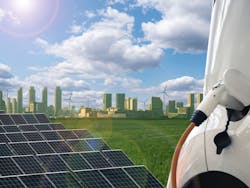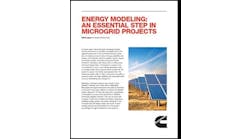Policy, economic and environmental issues are expected to dramatically boost demand for electric vehicles (EVs), a phenomenon that is spurring more utility microgrids.
In fact, three utilities — Pacific Gas & Electric (PG&E), Portland General Electric (PGE) and Florida Power and Light (FPL) — have plans to deploy microgrids to take advantage of EV batteries’ ability to support the grid and to help meet the increased demand for electricity from EV charging.
In addition, Commonwealth Edison plans to include EVs in its Bronzeville Community Microgrid project.
One factor fueling the anticipated EV boom is the Biden-Harris Electric Vehicle Charging Action plan — an outgrowth of the Bipartisan Infrastructure Law — which calls for creating a public charging network that prioritizes access to rural and underserved communities. It’s expected to help the Biden administration reach its goal of 500,000 chargers across the country.
What’s more, inflation is expected to increase oil prices and boost sales of EVs, said Ivana Delevska, founder and CIO of SPEAR, which focuses on disruptive technology stocks.
“Increasing gasoline prices make EVs more cost effective,” Delevska said. Gasoline prices are about $3.34/gallon compared to $2.40/gallon a year ago. The cost of charging EVs is equivalent to about $1.70/gallon, she said. “This makes EVs two times cheaper today [on fuel consumption basis] compared to about 1.4 times cheaper one year ago.”
The federal Energy Information Administration estimates that the number of EVs, as a percent of light duty vehicles, will increase from less than 1% of the fleet in 2020 to 30% in 2050. “We use this as a guidepost for modeling, but believe that adoption could be even faster,” Delevska said.
The role of state policy
State mandates to reduce carbon emissions also are pushing EV adoption.
For example, California Gov. Gavin Newsom in September 2020 issued an executive order requiring sales of all new passenger vehicles to be zero-emission by 2035. The state is home to nearly half the EVs in the US.
PG&E, a big EV player in California, in October 2020 submitted a proposal to the California Public Utilities Commission to install new infrastructure for 16,000 additional charging ports.
A microgrid that pairs with EVs appears to be on the horizon for PG&E.
“We see EVs as having significant capabilities not as just assets that will greatly reduce carbon emissions, but also as assets that will provide great value to our customers and to the distribution and transmission systems,” said Ari Vanrenen, spokesperson for PG&E. “We’ll have more to share about vehicle grid integration and microgrids in the next few months.”
A 2018 pilot by PG&E found that vehicle-to-home technology is technically capable of islanding and supporting household load during outages and demand response events.
Also planning a microgrid to pair with EVs is FPL. The FPL Evolution Hub under construction in Riviera Beach, Florida, will include a microgrid with 5 MW of PV and a 7.5 MW/15 MWh stationary battery plus two mobile EV trailers, said Ashley Fogg Schutz, a spokesperson for FPL. Each trailer will include a 650 kW/1.3 MWh battery paired with six level 3 EV chargers. The trailers will be used during emergency or hurricane evacuations. Florida is home to the second highest numbers of EVs.
FPL is installing more than 1,000 charging ports at more than 100 locations throughout the state. This includes a network of fast chargers along its busy highways.
And PGE is planning a microgrid at Electric Island, which is a public charging site for heavy duty electric trucks and buses. It’s part of the West Coast Clean Transit Corridor Initiative, a collaborative effort to electrify Interstate 5 from Vancouver, British Columbia, to San Diego, California, said John Farmer, senior communications consultant for PGE.
Electric vehicle charging will be available as part of the microgrid, he said.
“Microgrids play an important role in building a clean, flexible and resilient system in support of a clean energy future and may be practical solutions where energy management or resiliency is critical to the EV customer’s mission,” Farmer said. “However, it’s not practical for us to get there on our own and we are partnering with our customers to build an equitable, two-way grid of the future.”
PGE is now offering to customers a Smart Battery Pilot program under which PGE operates batteries located in customers’ homes and provides a monthly payment to the customers.
Utilities tackle range anxiety
To help reduce range anxiety and encourage people to buy EVs, many utilities, including PGE, PG&E, Eversource and FPL, have joined the Edison Electric Institute’s National Electric Highway Coalition, which includes 51 investor-owned electric companies, one electric cooperative and the Tennessee Valley Authority. It aims to provide fast charging ports allowing the public to drive EVs along major US travel corridors by the end of 2023.
Meanwhile, microgrid operators and other technology companies are keen to pair EV charging with microgrids.
Scale Microgrid Solutions and Proterra, which manufactures EVs, have received California Energy Commission funding to install a solar and battery storage microgrid that will power a fleet of 34 electric buses for the Santa Clara Valley Transportation Authority (VTA). During outages, electricity stored in the battery can provide power at VTA’s Cerone bus yard, ensuring bus transportation continues, according to a press release from Proterra.
On a typical day, the solar microgrid will allow the transportation authority to produce renewable energy and purchase off-peak energy from PG&E, which it will store in the battery for use during peak price periods. It’s expected to come online in late 2023. VTA will deploy about 1.5 MW of solar on-site through rooftop space and a carport canopy at the bus yard. The battery storage system can store 4 MWh of electricity and 1 MW of peak output power at the yard for up to 20 hours of emergency backup.
Wireless charging and microgrids
Tim Sylvester, founder and CEO of smart infrastructure technology provider Integrated Roadways, provider of Smart Pavement, which can wirelessly charge EVs as they travel, said that microgrids will be an important part of wireless EV charging.
“We expect that as the system matures, we’ll be able to incorporate smart microgrids at the roadside with battery storage and demand smoothing that can wirelessly charge EVs during the day when sustainable power is plentiful, reducing overnight demands on the grid,” Sylvester said.
Whether companies are utilities looking to accelerate EV adoption or technology providers, they agree that EVs and microgrids go hand in hand. The batteries in EVs can provide services to microgrids and the grid. And microgrids can help manage the high demand expected from the adoption of EVs.
Track news about utility microgrids. Subscribe to the free Microgrid Knowledge Newsletter.








